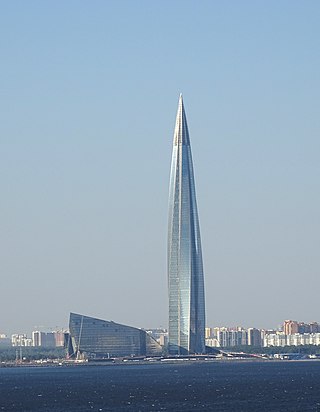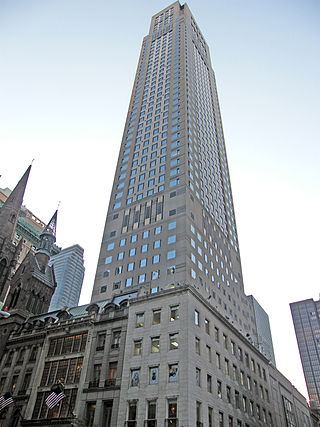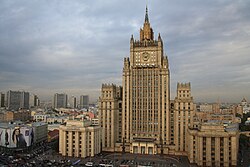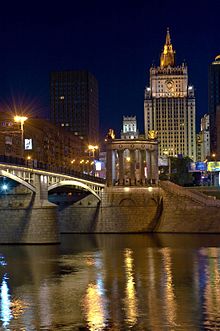
The White House, also known as the Russian White House and previously known as the House of Soviets of Russia, is a government building in Moscow. It stands on the Krasnopresnenskaya Embankment. The building serves as the primary office of the government of Russia and is the official workplace of the Russian Prime Minister.

The Franklin Center is a 60-story supertall skyscraper in the Loop neighborhood of downtown Chicago. Completed in 1989 as the AT&T Corporate Center to consolidate the central region headquarters of the American Telephone & Telegraph Company (AT&T), it stands at a height of 1,007 ft (307 m) and contains 1.7 million sq ft (160,000 m2) of floor space. It is located two blocks east of the Chicago River and northeast of the Willis Tower with a main address of 227 West Monroe Street and an alternate address of 100 South Franklin Street.

The Grand Kremlin Palace is a building in the Moscow Kremlin. For much of the 19th century, it served as the official residence of the Russian emperor in Moscow, which was not then the capital of the Russian Empire. Designed by a team of architects under the management of Konstantin Thon, architect of the Kremlin Armoury and the Cathedral of Christ the Saviour, the palace was intended to emphasise the greatness of Russian autocracy.

The Rossiya Hotel was a hotel in Moscow and was the largest hotel in the world from 1967 to 1980. Until its closure in 2006, it remained the second largest hotel in Europe, with 3,182 rooms. Throughout its existence, the hotel welcomed about ten million guests, including more than two million foreigners. Famous hotel guests included Mikhail Gorbachev, George H. W. Bush and Mike Tyson.

The Seven Sisters are a group of seven skyscrapers in Moscow designed in the Stalinist style. They were built from 1947 to 1953. At the time of construction, they were the tallest buildings in Europe, and the main building of Moscow State University remained the tallest building in Europe until 1990.

The Fuller Building is a skyscraper at 57th Street and Madison Avenue in the Midtown Manhattan neighborhood of New York City. Designed by Walker & Gillette, it was erected between 1928 and 1929. The building is named for its original main occupant, the Fuller Construction Company, which moved from the Flatiron Building.

The Sadberk Hanım Museum is a private museum on the shores of the Bosphorus in the Büyükdere neighbourhood of Sarıyer district in Istanbul, Turkey. It was established by the Vehbi Koç Foundation in memory of Vehbi Koç’s deceased wife Sadberk. The museum is open every day except Wednesdays.

Prospekt Mira is a station of the Moscow Metro's Koltsevaya line. Opened on 30 January 1952 as part of the second stage of the line, it is a pylon design by architects Vladimir Gelfreykh and Mikhail Minkus.
The Eighth Sister is the unbuilt project for a skyscraper in Zaryadye, Moscow. It would have been the eighth sister to the group of Stalinist skyscrapers known as Seven Sisters. The architect was Dmitry Chechulin.

The New Michael Palace was the third Saint Petersburg palace designed by Andrei Stackenschneider for Nicholas I's children. It was built between 1857 and 1862 on the Palace Embankment, between the Hermitage Museum buildings and the Marble Palace.

The Lakhta Centre is an 87-story skyscraper built in the northwestern neighbourhood of Lakhta in Saint Petersburg, Russia. Standing 462 metres (1,516 ft) tall, it is the tallest building in both Russia and Europe, and the sixteenth-tallest building in the world. It is also the second-tallest structure in Russia and Europe, behind the Ostankino Tower in Moscow, in addition to being the second-tallest twisted building and the northernmost skyscraper in the world.

The former Asia Insurance Building, now named Ascott Raffles Place, lies in the heart of the Central Business District of Singapore, at the corner of Finlayson Green and Raffles Quay. Standing at 270 feet, it surpassed the Cathay Building to be the tallest tower in Singapore until the completion of Meritus Mandarin Tower 1 in 1971. Designed by one of Singapore's pioneer architects, Ng Keng Siang, the office building was completed in 1955 and served as the headquarters for the Asia Insurance Company, one of the first local insurance companies. In 2006, the building was acquired by the Ascott Group and the office tower has since been refurbished into a serviced apartment residence. Renamed as Ascott Raffles Place, the building sits on a 999-year leasehold site with a building footprint of about 950 square meters.

111 Somerset is a high-rise commercial building and shopping mall in Orchard, Singapore. The building was first known as Public Utilities Board Building until 1995, and was later known as Singapore Power Building until 2008 when acquired by YTL Corporation Pacific Star. It used to house the headquarters of SP Group, until it shifted to its current site at Kallang.

712 Fifth Avenue is a 650-foot-tall (200 m) skyscraper at 56th Street and Fifth Avenue in the Midtown Manhattan neighborhood of New York City. Constructed from 1987 to 1990, it was designed by SLCE Architects and Kohn Pedersen Fox Associates. The skyscraper's base includes the Coty Building at 714 Fifth Avenue and the Rizzoli Bookstore building at 712 Fifth Avenue, both of which are New York City designated landmarks.

Singer House, also widely known as the House of the Book, is a historic building in Saint Petersburg, Russia. It is located at the intersection of Nevsky Prospekt and the Griboyedov Canal, directly opposite the Kazan Cathedral. It is recognized as a historical landmark and has official status as an object of Russian cultural heritage.

The Red Gate Building is one of seven Stalinist skyscrapers, designed by Alexey Dushkin. Its name comes from the Red Gate square.

The Brooklyn Tower is a supertall mixed-use, primarily residential skyscraper in the Downtown Brooklyn neighborhood of New York City. Developed by JDS Development Group, it is situated on the north side of DeKalb Avenue near Flatbush Avenue. The main portion of the skyscraper is a 74-story, 1,066-foot (325 m) residential structure designed by SHoP Architects and built from 2018 to 2022. Preserved at the skyscraper's base is the Dime Savings Bank Building, designed by Mowbray and Uffinger, which dates to the 1900s.

Wales House is a heritage-listed former newspaper office building, bank building and now hotel located at 64–66 Pitt Street, in the Sydney central business district, in the City of Sydney local government area of New South Wales, Australia. It was designed by Manson & Pickering and built from 1922 to 1929 by Stuart Bros. It is also known as the Bank of NSW Building. The property is owned by Wales House Nominees Pty Ltd. It was added to the New South Wales State Heritage Register on 2 April 1999. Located on the junction of Pitt, Hunter and O'Connell Streets, the building served as offices for John Fairfax and Sons' The Sydney Morning Herald from 1927 to 1955 before being acquired by the Bank of New South Wales, commonly known as "The Wales", hence the building's name. The building has subsequently been converted into an international hotel, as part of the Radisson Blu hotel chain.

The City Mutual Life Assurance Building is a heritage-listed commercial building located at 60-66 Hunter Street, in the Sydney central business district, New South Wales, Australia. It was built during 1936. It is also known as CML Building and 10 Bligh Street. It was added to the New South Wales State Heritage Register on 2 April 1999.

The General Staff Building is the headquarters of the General Staff of the Russian Armed Forces, situated on Arbatskaya Square in Central Administrative Okrug of Moscow, Russia.





















